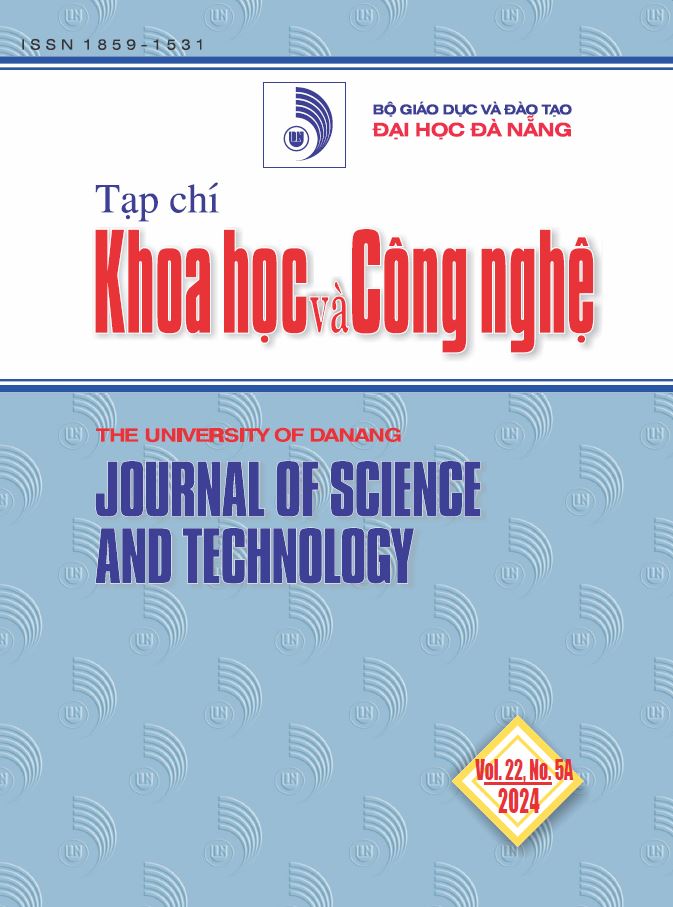Nghiên cứu ảnh hưởng của các điều kiện tổng hợp lên đặc tính sản phẩm carbon nano ống biến tính bằng nitơ
 Tóm tắt: 172
Tóm tắt: 172
 |
|  PDF: 103
PDF: 103 
##plugins.themes.academic_pro.article.main##
Author
-
Lê Đức NgưuNghiên cứu sinh, Viện Công nghệ Công nghiệp Hàn Quốc, Hàn QuốcNguyễn Đình LâmTrường Đại học Bách khoa - Đại học Đà Nẵng, Việt NamTrương Hữu TrìTrường Đại học Bách khoa - Đại học Đà Nẵng, Việt Nam
Từ khóa:
Tóm tắt
Ở nghiên cứu này, nhóm tác giả đã tiến hành khảo sát sự thay đổi về hiệu suất và các đặc tính của N-CNTs như hình thái bề mặt, giá trị BET, độ ổn định oxy hóa theo nhiệt độ tổng hợp và thể tích NH4OH. Trong khoảng nhiệt độ từ 600oC đến 750oC, hiệu suất thu sản phẩm đạt giá trị lớn nhất là 1015% khối lượng tại 710oC. Trong khi đó, kết quả ảnh chụp hiển vi điện tử quét và truyền qua đã khẳng định, vật liệu thu được là N-CNTs và đường kính N-CNTs có xu hướng tăng và ổn định khi nhiệt độ tổng hợp tăng. Giá trị diện tích bề mặt riêng có xu hướng giảm và ổn định dần khi nhiệt độ tổng hợp tăng. Độ ổn định oxy hóa của vật liệu tăng theo nhiệt độ tổng hợp. Bên cạnh đó, hiệu suất sản phẩm và giá trị BET khi được khảo sát theo thể tích NH4OH có cùng xu hướng thay đổi, tăng dần khi lượng NH4OH tăng từ 5 đến 10 ml, sau đó có xu hướng giảm xuống khi lượng NH4OH tăng đến 20 ml.
Tài liệu tham khảo
-
[1] P. D. Jong and J. W. Geus, "Carbon nanofibers: catalytic synthesis and applications", Catalysis Reviews, vol. 42, no. 4, pp. 481-510, 2000.
[2] S. Im, S. J. Kim, P. H. Kang, and Y. S. Lee, "The improved electrical conductivity of carbon nanofibers by fluorinated MWCNTs", Journal of Industrial and Engineering Chemistry, vol. 15, no. 5, pp. 699-702, 2009.
[3] Kumar and Y. Ando, "Chemical vapor deposition of carbon nanotubes: a review on growth mechanism and mass production", Journal of nanoscience and nanotechnology, vol. 10, no. 6, pp. 3739-3758, 2010.
[4] C. Ma, N. A. Siddiqui, G. Marom, and J. K. Kim, "Dispersion and functionalization of carbon nanotubes for polymer-based nanocomposites: a review", Composites Part A: Applied Science and Manufacturing, vol. 41, no. 10, pp. 1345-1367, 2010.
[5] P. Ewels, and M. Glerup, "Nitrogen doping in carbon nanotubes", Journal of Nanoscience and Nanotechnology, vol. 5, no. 9, pp. 1345-1363, 2005.
[6] J. Lee, S. C. Lyu, H. W. Kim, and J. H. Lee, "Synthesis of bamboo-shaped carbon–nitrogen nanotubes using C2H2–NH3–Fe (CO)5 system", Chemical physics letters, vol. 359, no. 1-2, pp. 115-120, 2002.
[7] Onoe, S. Iwamoto, and M. Inoue, "Synthesis and activity of the Pt catalyst supported on CNT", Catalysis Communications, vol. 8, no. 4, pp. 701-706, 2007.
[8] Wang, J. Yao, H. Li, D. Su, and M. Antonietti, "Highly selective hydrogenation of phenol and derivatives over a Pd@ carbon nitride catalyst in aqueous media", Journal of the American Chemical Society, vol. 133, no. 8, pp. 2362-2365, 2011.
[9] B. Sharma, D. J. Late, D. S. Joag, A. Govindaraj, and C. N. R. Rao, "Field emission properties of boron and nitrogen doped carbon nanotubes", Chemical physics letters, vol. 428, no. 1-3, pp. 102-108, 2006.
[10] Öztürk, and A. B. Yurtcan, "Synthesis of polypyrrole (PPy) based porous N-doped carbon nanotubes (N-CNTs) as catalyst support for PEM fuel cells", International Journal of Hydrogen Energy, vol. 43, no. 40, pp. 18559-18571, 2018.
[11] Yadav, P. Dobai, T. Shripathi, R. Katiyar, and O. Srivastava, "Effect of growth temperature on bamboo-shaped carbon–nitrogen (C–N) nanotubes synthesized using ferrocene acetonitrile precursor", Nanoscale research letters, vol. 4, no. 3, pp. 197-203, 2009.
[12] Hachimi, et al., "Synthesis of nitrogen-doped carbon nanotubes using injection-vertical chemical vapor deposition: effects of synthesis parameters on the nitrogen content", Journal of Nanomaterials, vol. 16, no. 1, pp. 425-433, 2015.
[13] D. Kim, H. R. Lee, and H. T. Kim, "Effect of NH3 gas ratio on the formation of nitrogen-doped carbon nanotubes using thermal chemical vapor deposition", Materials Chemistry and Physics, vol. 183, pp. 315-319, 2016.
[14] H. Tri, "Using ammonium hydroxide in synthesis of nitrogen-doped carbon nanotubes", Vietnam Journal of Science, Technology and Engineering, vol. 62, no. 8, pp. 55-58, 2020.
[15] Chizari, A. Vena, L. Laurentius, and U. Sundararaj, "The effect of temperature on the morphology and chemical surface properties of nitrogen-doped carbon nanotubes", Carbon, vol. 68, pp. 369-379, 2014.
[16] Ming, D. Peiling, Z. Yunlong, G. Jing, and R. Xiaoxue, "Effect of Reaction Temperature on Carbon Yield and Morphology of CNTs on Copper Loaded Nickel Nanoparticles", Journal of Nanomaterials, vol. 2016, pp. 1-5, 2016.
[17] Z.Li, J.G. Wen and Z.F. Ren,"Effect of temperature on growth and structure of carbon nanotubes by chemical vapor deposition", Applied Physics A, vol. 74, no. 3, p.397–402, 2002.
[18] N. Tetana, S. D. Mhlanga, G. Bepete, R. W. M. Krause, and N.J. Coville, "The Synthesis of Nitrogen-Doped Multiwalled Carbon Nanotubes Using an Fe-Co/CaCO3 Catalyst", South African Journal of Chemistry, vol. 65, pp. 39–49, 2012.
[19] H. Tri, "The effect of synthesis temperature on the carbon yield and characteristics of nanocomposite C-CNFs", The University of Danang – Journal of Science and Technology, vol. 18, no. 6, pp. 57-61, 2020.
[20] T. Mombeshora, A. L. L. Jarvis, P. G. Ndungu, B. P. Doyle, E. Carleschi, and V. O. Nyamori, "Some perspectives on nitrogen-doped carbon nanotube synthesis from acetonitrile and N, N-dimethylformamide mixtures", Materials Chemistry and Physics, vol. 199, pp. 435-453, 2017.
[21] N. Nxumalo, V. O. Nyamori, and N. J. Coville, "CVD synthesis of nitrogen-doped carbon nanotubes using ferrocene/aniline mixtures", Journal of Organometallic Chemistry, vol. 693, no.17, pp. 2942–2948, 2008.
[22] E. M. M. Ibrahim et al., "Synthesis, characterization, and electrical properties of nitrogen-doped single-walled carbon nanotubes with different nitrogen content", Diamond & Related Materials, vol. 19, no. 10, pp. 1199–1206, 2010.



